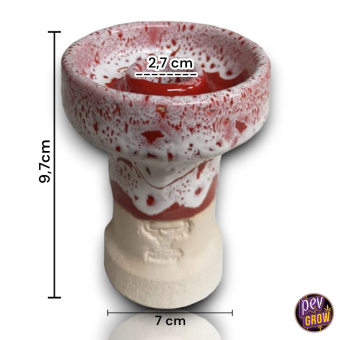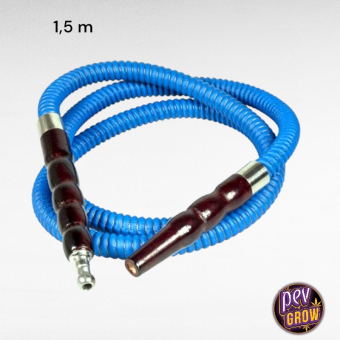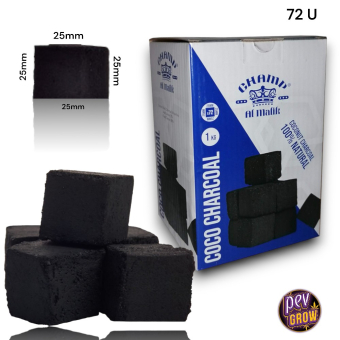- Learn everything about Egyptian Hookahs: origin, what they are, how they work, and essential parts. We answer your frequently asked questions about this popular device for smoking weed.
- How to Smoke Moonrocks
- How to Smoke Pre-Rolled Joints


In constant struggle for the regulation of cannabis, mainly in the medicinal field.
06-06-2024 06:48:26 - Updated: 6 June, 2024
Welcome to the Pevgrow blog! In this post, we will explain everything you need to know about Egyptian Hookahs, also known as shisha, hookah, or narghile. These elegant and traditional pieces have been used for centuries across various cultures and have gained global popularity for their ability to provide a social and relaxing smoking experience. Keep reading to discover their origin, how they work, their essential parts, and answers to the most common questions about Egyptian Hookahs.
👌 What is an Egyptian Hookah?
An Egyptian Hookah, also known as shisha, hookah, or narghile, is a traditionally used device for smoking hookah tobacco that has been mixed with molasses, honey, and various aromatic flavors. Originating in India and popularized in the Middle East, the hookah has been an integral part of the culture of many societies, evolving over time to become a symbol of socialization and relaxation worldwide.
The hookah has a rich and fascinating history dating back to the 16th century in India. The earliest models were rudimentary and consisted of a simple coconut serving as the base, connected to a bamboo tube. This basic design was adopted and refined in Persia, where more sophisticated materials such as glass and metal were incorporated, and more advanced manufacturing techniques were developed.
The hookah reached the Ottoman Empire, where it became an important part of social culture. The Ottomans perfected its design and integrated it into their daily lives, making it a conversation piece in coffee houses and meeting lounges. From there, it spread throughout the Middle East and North Africa, acquiring different names and styles depending on the region.
👾 Parts of an Egyptian Hookah
- Base (Vase): The base is one of the most fundamental parts of the hookah. Generally made of glass, though it can also be found in acrylic, metal, and ceramic, the base is filled with water which acts as a filter and cooler of the smoke. The shape and size of the base can vary, influencing the stability and the amount of water it can hold. A well-designed base should provide an airtight seal when joined with the body, ensuring that the smoke properly passes through the water.
- Body (Stem): The body, or stem, is the main tube that connects the base with the bowl. This component can be made from a variety of materials such as stainless steel, brass, aluminum, or wood. The stem can be smooth or decorated with intricate designs, and its height can vary, affecting the length of the smoke’s journey and, therefore, its cooling. The upper section of the stem usually has a connector for the bowl and, in some designs, a purge valve to release excess smoke from inside the base.
- Bowl: The hookah bowl is the container where the tobacco is placed. Commonly made of ceramic, clay, silicone, or metal, the bowl has holes in its base to allow the hot air to pass through the tobacco. There are various types of bowls, such as traditional, phunnel, and vortex, each designed to optimize heat distribution and airflow, impacting the duration and quality of the smoking session.
- Tray (Plate): The tray is located just below the bowl and serves to catch ashes and charcoal remnants. This component, generally made of metal, is also useful for placing the lit charcoals before being used. An efficient tray should be large enough to catch all the ashes and residues, preventing them from falling into the base or the surrounding area.
- Hose: The hose is the flexible conduit through which the smoke is inhaled. Modern hookah hoses are made with washable materials like silicone, making them easy to clean and maintain. The length of the hose can vary, and some hoses have detachable mouthpieces to improve hygiene. There are hoses with multiple connections, allowing several people to smoke at the same time without needing to share a single mouthpiece.
- Mouthpiece: The hookah mouthpiece is the final part of the hose through which the smoke is inhaled. It can be made of plastic, metal, wood, or glass. Disposable mouthpieces are recommended to maintain hygiene, especially when the hookah is shared among several people. Additionally, there are mouthpieces of different sizes and shapes, some designed ergonomically for greater comfort while smoking.
- Diffuser (Optional): The diffuser is an additional piece that is placed on the lower end of the stem, submerged in the water. Its function is to divide the air bubbles into smaller ones, making the filtering more efficient and reducing the noise when smoking. Not all hookahs come with a diffuser, but it is an accessory that many users consider essential for a smoother and quieter experience.
🎯 Culture and Meaning of Egyptian Hookahs
In many cultures, the Egyptian Hookah is not just a smoking device; it is a symbol of hospitality and community. Sharing a hookah is a social act that promotes conversation and camaraderie. In the Middle East, for example, coffee houses have historically been centers of social activity where people gather to discuss the day’s matters, play chess, or simply enjoy each other’s company while smoking a hookah.
The ritual of preparing and smoking a hookah is also a meditative experience. The process of lighting the hookah charcoal, preparing the tobacco, and assembling the device requires time and attention, which can be a way to relax and disconnect from the daily hustle.
🚀 Evolution of Egyptian Hookahs and Modern Popularity
The popularity of the Egyptian Hookah has grown significantly in recent decades, extending beyond its traditional roots to gain global acceptance. In Europe and America, shishas are found in specialized bars and lounges, attracting a diverse clientele who enjoy the unique experience of smoking flavored tobacco in a social setting.
The evolution of the hookah has seen the introduction of modern materials and technologies that enhance the smoking experience. Today, hookahs are available in a wide range of designs and sizes, from traditional handmade models to modern versions with advanced features such as diffusers and heat management systems.
🔥 Conclusion
The Egyptian Hookah is a device with a rich cultural history that has evolved significantly from its origins in India. Beyond being simply a method for smoking tobacco, it represents a deeply rooted social and cultural act in various parts of the world. As it continues to gain global popularity, the hookah remains a symbol of community and relaxation, offering a unique experience both in its preparation and use. This is one of many ways to smoke, but there are many more, and if you’re eager to discover other methods, here’s another article that explains how to smoke weed in a pipe.
➕ Frequently Asked Questions about Egyptian Hookahs
Where does the Egyptian Hookah come from?
The Egyptian Hookah originated in India and became popular in the Middle East. It is believed that the first designs were created in the 16th century, and since then, it has been a significant cultural element in many Arab and Asian societies. Its use spread through the centuries, adapting and evolving in different cultures.
Is the Egyptian Hookah bad?
Smoking a hookah can have health risks similar to those of smoking cigarettes, including exposure to carbon monoxide and toxic substances. Although water can filter some toxins, it does not eliminate all risks. Occasional use in a social setting is perceived as less harmful compared to the daily smoking habit, but it is important to use the hookah responsibly and be aware of the associated risks.
What does “hookah” mean?
The word “hookah” comes from the Portuguese term “cachimbo,” which means “pipe.” It refers to a smoking device that uses water to cool and filter the smoke before it is inhaled. It is also known as shisha, hookah, or narghile in different regions of the world. Each term has its cultural and linguistic origin, but all describe the same type of device.











After reading this article, I finally understand all the details about hookahs, I’m ready to choose the best one for my social gatherings!